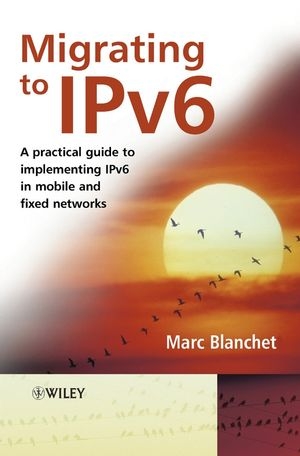
Migrating to IPv6
John Wiley & Sons Inc (Verlag)
978-0-471-49892-6 (ISBN)
- Titel erscheint in neuer Auflage
- Artikel merken
Understand IPv6, the protocol essential to future Internet growth. Exhaustion of address space and global routing table growth necessitate important revisions to the current version of the Internet Protocol, IPv4. IP version 6 offers greater address space and additional features to support the evolving requirements of Internet applications. Deployed alongside current IPv4 networks, IPv6 will restore the full-fledge network necessary for Internet growth.
Migrating to IPv6 gives a comprehensive overview of IPv6 and related protocols, the layers below IPv6 to the application and end-user layers. Author Marc Blanchet offers a direct and clear route to understanding the topic, taking a top-down approach and ordering topics by relevance. Tried and tested practical techniques and advice on implementation, applications and deployment provide ‘how-to’ information on everything you need to know to put the technology to work.
Migrating to IPv6:
Provides a complete, up-to-date, in-depth, and accessible practical guide to IPv6.
Demonstrates the theory with practical and generic examples and major implementation configurations, such as Windows, FreeBSD, Linux, Solaris, Cisco, Juniper and Hexago.
Provides a comprehensive reference to key data structures and packet formats.
Summarizes topics in table and graphical form to give fast access to information, including over 200 figures.
Offers an accompanying website with extra coverage of specific topics, information on additional protocols and specifications, and updates on new features.
This text will give network engineers, managers and operators, software engineers and IT professionals and analysts a thorough understanding of IPv6.
Marc Blanchet is CTO at Hexago. Hexago sells an IPv6 deployment product which implements the TSP tunnel broker. Hexago is a spin-off of Viagénie, known for the 6tap exchange point, normos, freenet6, the Tunnel Setup Protocol and other IPv6 initiatives, all of which Marc was architect and co-implementor of. In his previous job at Viagénie, he was a network security consultant for enterprises, governments and providers. Marc co-founded the IPv6Forum, and is a member of the board and technical directorate. He is also director and member of the steering committee of the North American IPv6 task force. Marc was co-chair of the internationalized domain names (idn) IETF working group and co-chair of the IPv6 exchanges ad hoc working group. He has written several IETF drafts and RFC in both the IPv6(RFC3531) and idn (RFC3454, RFC3491) fields. Since 1999, he has been giving IPv6 tutorials at conferences such as Networld-Interop, INET, IPv6Forum, 3G, Security and to organizations, taught to many thousands of people, and he also co-authored the Cisco IPv6 course. Marc received a master's degree in electrical engineering from Laval University. Marc, as author, can be reached at author@ipv6book.ca
Foreword. Preface.
1 IPv6 Rationale and Features.
1.1 Internet Growth.
1.2 Real Issues and Trouble with IPv4.
1.3 Architectural Considerations.
1.4 Paradigm Shift.
1.5 IETF Work Towards IPv6.
1.6 IPv6 Main Features.
1.7 IPv6 Milestones.
1.8 IPv6 Return on Investment.
1.9 What Happened to IPv5?
1.10 Summary.
1.11 References.
2 I Can’t Wait to Get my Hands Dirty!
2.1 Setup Description.
2.2 Steps.
2.3 Summary.
2.4 References.
2.5 Further Reading.
3 IPv6 Datagram.
3.1 Description of the IP Datagram.
3.2 IPv4 Header.
3.3 IPv6 Header.
3.4 Header Fields.
3.5 Extension Headers.
3.6 Datagram Size.
3.7 Upper-layer Protocols.
3.8 Summary.
3.9 References.
4 Addressing.
4.1 Address Space.
4.2 Format of an Address.
4.3 Unicast Addresses.
4.4 Multicast Addressing.
4.5 Anycast.
4.6 Addressing Architecture.
4.7 Summary.
4.8 References.
4.9 Further Reading.
5 Configuring Node Addresses.
5.1 Static Address Configuration.
5.2 Address Auto-Configuration.
5.3 Lifetime of Advertised Prefixes.
5.4 Node Booting Process.
5.5 DHCPv6.
5.6 Node Addresses.
5.7 Configuring Interfaces and Router Advertisements on Hosts and Routers.
5.8 Summary.
5.9 Appendix.
5.10 References.
6 Link-layer Integration.
6.1 Solicited-Node Multicast Address.
6.2 Neighbor Solicitation and Advertisement.
6.3 Duplicate Address Detection.
6.4 Neighbor Cache.
6.5 EUI-64 and Neighbor Discovery.
6.6 IPv6 over Ethernet.
6.7 Point-to-Point Links.
6.8 Multi-link Subnets.
6.9 Router Advertisements of the Link MTU.
6.10 Managing Neighbors on Hosts and Routers.
6.11 Summary.
6.12 References.
6.13 Further Reading.
7 Internet Control Message Protocol.
7.1 ICMP.
7.2 Neighbor Discovery.
7.3 Hop Limit Set to 255.
7.4 Managing ICMP on Hosts and Routers.
7.5 Summary.
7.6 References.
8 Naming with DNS and Selecting an Address.
8.1 Hostname To IPv6 Address with the AAAA Record.
8.2 IPv6 Address To Hostname.
8.3 Transport.
8.4 DNS Server Discovery.
8.5 Node Information Query.
8.6 IP Address Selection.
8.7 Configuring DNS and Address Selection on Hosts and Routers.
8.8 Summary.
8.9 References.
8.10 Further Reading.
9 Routing.
9.1 Required Router Addresses.
9.2 Source Routing with the Routing Header.
9.3 Route Redirect.
9.4 Static Routes.
9.5 RIP.
9.6 OSPF.
9.7 IS-IS.
9.8 BGP.
9.9 Tunneling IPv6.
9.10 Renumbering Routers.
9.11 Internet Routing.
9.12 Multihoming.
9.13 Summary.
9.14 References.
10 Configuring Routing.
10.1 Considerations on Using Autoconfiguration for Router Interfaces.
10.2 FreeBSD.
10.3 Linux.
10.4 Solaris.
10.5 Windows.
10.6 Cisco.
10.7 Hexago.
10.8 Juniper.
10.9 Zebra.
10.10 Summary.
10.11 Further Reading.
11 Mobility.
11.1 Overview.
11.2 MobileIP.
11.3 Applications are not Aware of Mobility.
11.4 Mobile Node is at Home.
11.5 Mobile Node is away from Home.
11.6 Mobile Node is Moving Again.
11.7 Mobile Node Comes Back Home.
11.8 Securing the Binding Update.
11.9 Correspondent Node is Not MobileIP Aware.
11.10 Advanced Features.
11.11 MobileIP Messaging.
11.12 Deployment Considerations.
11.13 Configuring Mobility.
11.14 Summary.
11.15 References.
12 Wireless IP.
12.1 Characteristics of Wireless Links.
12.2 Header Compression over Limited Bandwidth Link Layers.
12.3 TCP Behavior over Wireless.
12.4 3GPP.
12.5 3GPP2.
12.6 Summary.
12.7 References.
12.8 Further Reading.
13 Security.
13.1 IP Security (IPsec).
13.2 Secure Shell (SSH).
13.3 Filtering and Firewalls.
13.4 Temporary Addresses.
13.5 More Secure Protocols.
13.6 Securing IPv6 on the Link.
13.7 Is IPv6 More Secure?
13.8 Configuring Security on Hosts and Routers.
13.9 Summary.
13.10 References.
14 Quality of Service.
14.1 IPv5: Streaming Protocol.
14.2 Diffserv.
14.3 Integrated Services.
14.4 Network Address Translation.
14.5 Hardware processing.
14.6 Configuring QoS on Hosts and Routers.
14.7 Summary.
14.8 References.
15 Multicast and Anycast.
15.1 Multicast Basics.
15.2 Multicast Listener Discovery.
15.3 Multicast Routing.
15.4 Multicast Address Allocation.
15.5 Unicast-based Multicast Addressing.
15.6 Allocation of Multicast Addresses.
15.7 Multicast Reserved Addresses.
15.8 Anycast.
15.9 Configuring Anycast and Multicast on Hosts and Routers.
15.10 Summary.
15.11 References.
16 Deploying IPv6 in IPv4 Dominant Networks.
16.1 Combined IPv4 and IPv6 Network.
16.2 Tunneling IPv6 in IPv4.
16.3 Tunneling IPv6 in GRE-IPv4.
16.4 Comparing IPv6 in IPv4 Solutions.
16.5 Configuring IPv6 in IPv4 Dominant Networks.
16.6 Summary.
16.7 References.
17 Deploying IPv6 Dominant Networks with IPv4 Support.
17.1 Tunneling IPv4 in IPv6.
17.2 IP Packet and Transport Translation.
17.3 Configuring IPv4 in IPv6 Dominant Networks.
17.4 Summary.
17.5 References.
18 Migrating with Application Level Gateways.
18.1 Application Level Gateway.
18.2 Application Specific Proxy.
18.3 Considerations of Application Level Gateways.
18.4 Summary.
19 Transport Protocols.
19.1 Checksum.
19.2 Transmission Control Protocol (TCP).
19.3 User Datagram Protocol (UDP).
19.4 Internet Control Message Protocol (ICMP).
19.5 Summary.
19.6 References.
20 Network Management.
20.1 SNMP Transport.
20.2 Management Information Base (MIB).
20.3 Other Management Tools.
20.4 Authentication, Authorization and Accounting using RADIUS.
20.5 Configuring SNMP on Hosts and Routers.
20.6 Summary.
20.7 References.
21 Porting Applications.
21.1 Introduction.
21.2 Considerations.
21.3 Structures.
21.4 Functions.
21.5 Change Table.
21.6 Best Practice.
21.7 Basic Example.
21.8 Summary.
21.9 References.
21.10 Further Reading.
22 Configuration and Usage of IPv6-enabled Open Source Software.
22.1 Apache Web Server.
22.2 Sendmail.
22.3 Postfix.
22.4 SSH.
22.5 XFree86.
22.6 MRTG.
22.7 Dovecot.
22.8 Summary.
22.9 References.
23 Best Current Practices and Case Studies.
23.1 IPv6 Internet Address Space.
23.2 IPv6 Address Policy.
23.3 IPv6 Address Planning.
23.4 Incremental Deployment.
23.5 DNS Considerations.
23.6 Routing Considerations.
23.7 Security Considerations.
23.8 Mail Considerations.
23.9 Deploying IPv6 and Connecting to the IPv6 Internet.
23.10 Summary.
23.11 References.
23.12 Further Reading.
24 Conclusion.
25 Quick Reference.
Index.
| Erscheint lt. Verlag | 23.1.2006 |
|---|---|
| Verlagsort | New York |
| Sprache | englisch |
| Maße | 177 x 252 mm |
| Gewicht | 964 g |
| Themenwelt | Mathematik / Informatik ► Informatik ► Netzwerke |
| Technik ► Elektrotechnik / Energietechnik | |
| ISBN-10 | 0-471-49892-0 / 0471498920 |
| ISBN-13 | 978-0-471-49892-6 / 9780471498926 |
| Zustand | Neuware |
| Haben Sie eine Frage zum Produkt? |
aus dem Bereich



